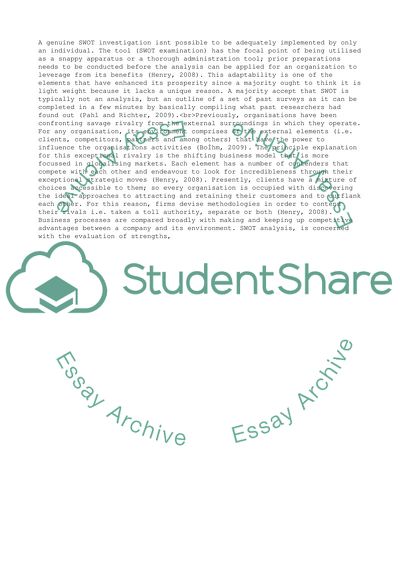Cite this document
(“The SWOT analysis became a basis from which a companys strategy is Essay - 1”, n.d.)
The SWOT analysis became a basis from which a companys strategy is Essay - 1. Retrieved from https://studentshare.org/management/1682624-the-swot-analysis-became-a-basis-from-which-a-companys-strategy-is-built-however-when-used-it-in-a-wrong-manner-it-can-jeopardize-the-future-of-a-company-using-some-specific-examples-of-your-choice-evaluate-the-swot-model
The SWOT analysis became a basis from which a companys strategy is Essay - 1. Retrieved from https://studentshare.org/management/1682624-the-swot-analysis-became-a-basis-from-which-a-companys-strategy-is-built-however-when-used-it-in-a-wrong-manner-it-can-jeopardize-the-future-of-a-company-using-some-specific-examples-of-your-choice-evaluate-the-swot-model
(The SWOT Analysis Became a Basis from Which a Companys Strategy Is Essay - 1)
The SWOT Analysis Became a Basis from Which a Companys Strategy Is Essay - 1. https://studentshare.org/management/1682624-the-swot-analysis-became-a-basis-from-which-a-companys-strategy-is-built-however-when-used-it-in-a-wrong-manner-it-can-jeopardize-the-future-of-a-company-using-some-specific-examples-of-your-choice-evaluate-the-swot-model.
The SWOT Analysis Became a Basis from Which a Companys Strategy Is Essay - 1. https://studentshare.org/management/1682624-the-swot-analysis-became-a-basis-from-which-a-companys-strategy-is-built-however-when-used-it-in-a-wrong-manner-it-can-jeopardize-the-future-of-a-company-using-some-specific-examples-of-your-choice-evaluate-the-swot-model.
“The SWOT Analysis Became a Basis from Which a Companys Strategy Is Essay - 1”, n.d. https://studentshare.org/management/1682624-the-swot-analysis-became-a-basis-from-which-a-companys-strategy-is-built-however-when-used-it-in-a-wrong-manner-it-can-jeopardize-the-future-of-a-company-using-some-specific-examples-of-your-choice-evaluate-the-swot-model.


